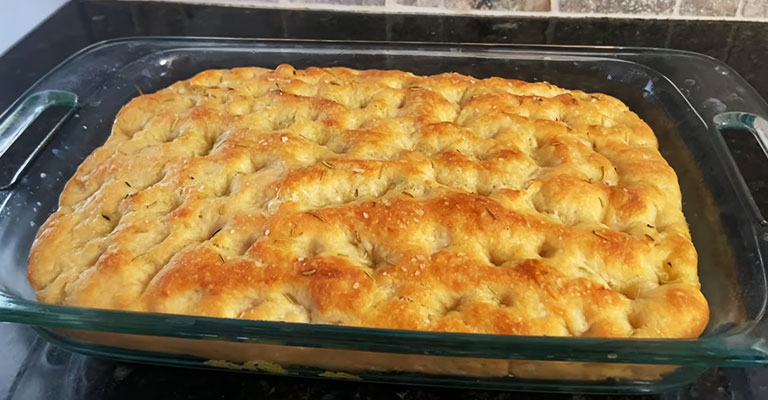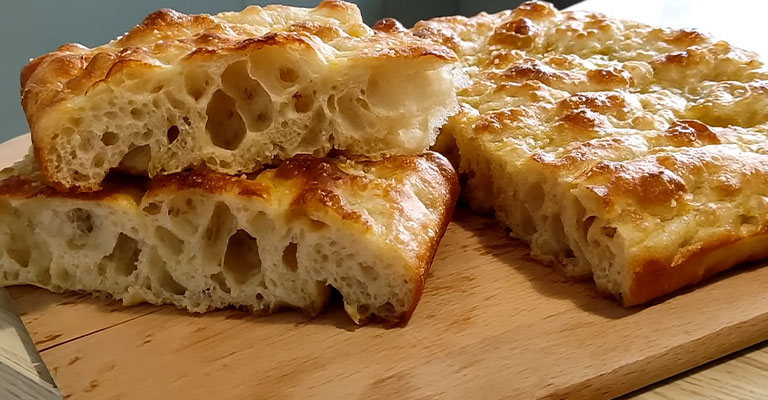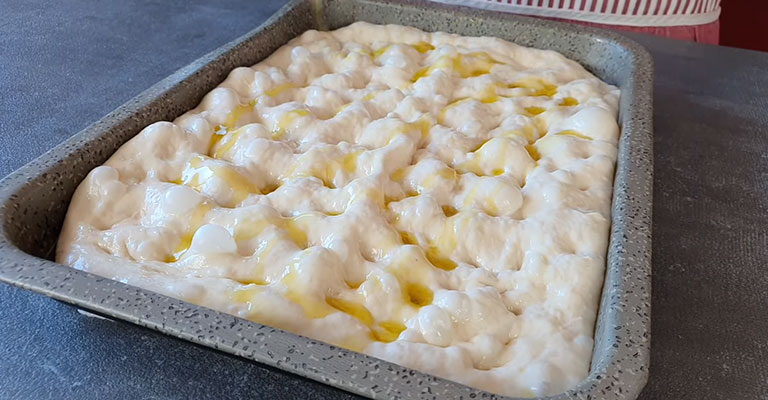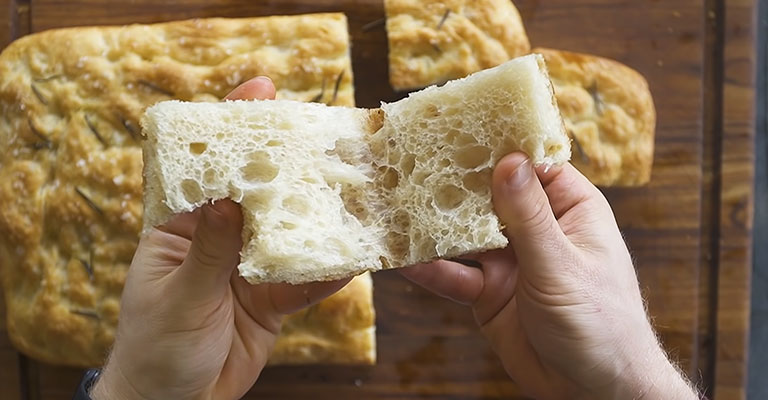Why Didn’t My Focaccia Rise?-Understanding the Rising Issues
Embarking on the art of baking, particularly in the pursuit of crafting the perfect focaccia, is a rewarding endeavor. Yet, when faced with a flat or underwhelming rise, the experience can be a touch disheartening.
The intricacies behind why focaccia may not achieve its expected height are multifaceted, encompassing elements from yeast vitality to kneading finesse and proofing conditions.
This guide endeavors to demystify the reasons behind a lackluster rise, providing valuable insights and practical solutions for aspiring bakers.
Armed with knowledge and precision, attaining a beautifully risen focaccia becomes an achievable culinary feat, promising both satisfaction and delectable results.

What Is Focaccia in Cooking?
Focaccia is a versatile and beloved Italian flatbread, renowned for its tender, airy texture and rich, olive oil-infused flavor. Originating from ancient Roman times, this bread has evolved into a staple of Mediterranean cuisine.
It’s characterized by its dimpled surface, created by pressing fingertips into the dough before baking.
Focaccia’s dough is a simple blend of flour, water, yeast, salt, and olive oil, which undergoes a crucial rising process. It can be seasoned with various toppings like rosemary, garlic, sea salt, tomatoes, olives, or even cheese.
Focaccia serves as an excellent accompaniment to meals, a base for sandwiches, or a canvas for imaginative culinary creations. Its rustic charm and versatility make it a cherished favorite in kitchens worldwide.
Why Didn’t My Focaccia Rise?
Focaccia, with its airy crumb and golden crust, is a culinary delight that captivates many a home baker. However, there are times when this beloved Italian bread stubbornly refuses to rise to the occasion.
Here are some common reasons why your focaccia may not have risen:
Inactive Yeast
Active yeast is essential for proper dough rising. If you suspect your yeast is old or expired, it’s best to invest in a fresh batch.
Also, ensure that you store your yeast in an airtight container in the refrigerator to maintain its freshness.
Incorrect Water Temperature
The ideal water temperature for yeast activation is typically between 100-110°F (37-43°C).
Using a kitchen thermometer to measure the water temperature can help ensure it’s within this range.
Insufficient Kneading
Kneading dough strengthens the gluten, which is necessary for trapping gas produced by the yeast. Knead your dough for at least 10-15 minutes until it becomes smooth and elastic.
Insufficient Proofing Time
The dough needs sufficient time to rise and develop flavor. If your recipe specifies a certain proofing time, follow it. In most cases, you should allow the dough to double in size.
Improper Proofing Environment
Choose a warm, draft-free location for proofing your dough.
You can create an ideal environment by placing the dough in a lightly greased bowl, covering it with a damp cloth, and putting it in a turned-off oven with the light on. This provides a consistent, warm atmosphere.
Over-Proofing
Avoid over-proofing the dough. If it doubles in size and is left for too long, the yeast may run out of food, resulting in a less vigorous rise. Monitor the proofing process closely.
Incorrect Flour-to-Water Ratio
Follow the recipe’s measurements carefully. Measuring ingredients by weight with a kitchen scale is more accurate than using cups, which can vary based on how the flour is packed.
Inadequate Leavening Agent
When your recipe uses baking powder or baking soda, ensure they are fresh and added in the right quantity. Expired leavening agents lose their effectiveness.
Improper Handling of the Dough
When shaping the dough, handle it gently to avoid deflating it. Use a light touch to maintain the gas bubbles that will help the focaccia rise during baking.
Incorrect Baking Temperature
Oven temperature is crucial. Ensure your oven is properly preheated, and invest in an oven thermometer to verify the accuracy of the temperature. If your oven runs too hot or cold, it can affect the rise and texture of the focaccia.
Expired Ingredients
Always check the expiration dates of your ingredients, especially the leavening agents. Fresh ingredients are essential for successful bread-making.
Altitude and Humidity
High altitudes and varying humidity levels can affect dough rising. You may need to experiment with small adjustments in the recipe or proofing times to accommodate these environmental factors in your region.
The Importance of Rising in Focaccia

The rising phase in focaccia-making is a critical step that significantly influences the final texture, flavor, and overall quality of the bread.
Here’s why it’s so important:
Texture and Crumb Structure
Rising allows the yeast to ferment and produce carbon dioxide gas, which gets trapped in the dough.
This creates air pockets that give focaccia its characteristic airy, light, and tender texture. Without proper rising, the bread will be dense and lack the desirable crumb structure.
Flavor Development
During rising, the yeast also produces various flavor compounds, including alcohols, acids, and esters.
These compounds contribute to the complex, rich taste of the focaccia. A well-risen dough generally has a deeper and more developed flavor profile.
Improved Digestibility
The fermentation process that occurs during rising breaks down complex carbohydrates and proteins in the dough. This makes the bread more easily digestible and can also enhance nutrient absorption.
Gluten Development
The kneading and rising stages work together to develop gluten, a protein that gives the bread its structure and elasticity.
Properly developed gluten ensures the dough can hold the gas produced by the yeast, resulting in a well-risen focaccia.
Even the Distribution of Flavors
Rising helps distribute the flavors evenly throughout the dough. This means that every bite of the finished focaccia will have a consistent taste and aroma.
Improved Shelf Life
The fermentation process not only enhances flavor but also acts as a natural preservative.
Well-risen dough tends to stay fresh longer compared to dough that hasn’t been allowed to rise properly.
Aesthetics and Presentation
A properly risen focaccia will have an appealing, golden-brown crust and an even, open crumb structure.
This not only makes the bread visually appealing but also provides a satisfying eating experience.
Balanced Rise
Allowing the dough to rise for the right amount of time ensures a balanced rise.
This means that the focaccia will have a uniform height and texture, rather than being overly puffy in some areas and dense in others.
Controlled Fermentation
Proper rising also allows for controlled fermentation.
This means you can manage the development of flavors and the rise of the dough to achieve the desired outcome, whether you’re aiming for a quick, same-day focaccia or a longer, slower rise for enhanced flavor.
Satisfaction and Enjoyment
Successfully making focaccia that rises properly can be a source of great satisfaction for a baker.
The accomplishment of creating a light, flavorful bread from basic ingredients is a rewarding experience.
Resolving Focaccia Rising Issues

When your focaccia doesn’t rise as expected, it can be frustrating, but there are several troubleshooting steps you can take to improve your results.
Here are some common issues and their solutions:
Focaccia Didn’t Rise Properly
- Possible Causes: Inactive yeast, incorrect water temperature, insufficient kneading, or improper proofing.
- Solution: Use fresh yeast, ensure water is at the right temperature (100-110°F or 37-43°C), knead thoroughly, and allow adequate time for proofing.
Dense or Heavy Texture
- Possible Causes: Insufficient kneading, incorrect flour-to-water ratio, or expired leavening agents.
- Solution: Knead the dough until it’s smooth and elastic, measure ingredients accurately, and ensure the leavening agents are fresh.
Overly Sticky Dough
- Possible Causes: Too much water or not enough flour in the dough.
- Solution: Gradually add more flour while kneading until the dough reaches the desired consistency.
Dough Is Too Dry or Crumbly
- Possible Causes: Too much flour, not enough water, or incorrect measuring.
- Solution: Gradually add small amounts of water while kneading until the dough comes together.
Focaccia Is Too Thin or Flat
- Possible Causes: Underproofed dough, incorrect shaping, or using a pan that’s too large.
- Solution: Allow the dough to proof adequately, shape it gently without pressing too hard, and use an appropriately sized baking pan.
Uneven Rise or Large Air Pockets
- Possible Causes: Improper shaping or handling of the dough.
- Solution: Shape the dough evenly and gently to avoid creating large air pockets.
Focaccia Is Too Salty
- Possible Causes: Excessive salt in the recipe or adding additional salt on top before baking.
- Solution: Use the recommended amount of salt in the recipe and avoid adding extra on top.
Focaccia Has a Bitter Taste
- Possible Causes: Overproofed dough or using too much olive oil.
- Solution: Monitor the proofing time closely and use the recommended amount of olive oil.
Uneven Browning or Burning on Top
- Possible Causes: Oven temperature too high, placing the focaccia too close to the heating element, or using a dark baking pan.
- Solution: Lower the oven temperature slightly, move the rack to a lower position, or use a lighter-colored pan.
Focaccia Lacks Flavor
- Possible Causes: Insufficient proofing time or not using enough seasonings or toppings.
- Solution: Allow the dough to proof for an adequate amount of time, and be generous with toppings like herbs, garlic, and olive oil.
Tips for Perfect Focaccia Rising

Achieving a perfect rise is crucial for a light, airy, and flavorful focaccia.
Here are some tips to ensure your focaccia rises beautifully:
Use Fresh and Active Yeast
Check the expiration date on your yeast and ensure it’s still viable. Active yeast is essential for proper fermentation and rise.
Measure Ingredients Accurately
Precise measurements of flour, water, and other ingredients are crucial. Consider using a kitchen scale for the most accurate results.
Optimal Water Temperature
The water used to activate the yeast should be around 100-110°F (37-43°C). Too hot or too cold water can hinder yeast activation.
Balanced Flour-to-Water Ratio
Achieving the right consistency in the dough is key. It should be slightly tacky but not overly sticky. Adjust the flour or water as needed during kneading.
Thorough Kneading
Kneading develops gluten, which is essential for trapping gas and achieving a good rise. Knead for at least 10-15 minutes until the dough is smooth and elastic.
Proper Proofing Time
Allow the dough to rise in a warm, draft-free place. Depending on the recipe, this can take anywhere from 1 to 2 hours, or until the dough has doubled in size.
Monitor the Dough
Keep an eye on the dough while it’s proofing. Over-proofing can lead to a collapse during baking, while under-proofing can result in a dense texture.
Grease the Bowl
Lightly oil the bowl where the dough will rise. This helps prevent sticking and allows for easier removal after proofing.
Cover the Dough
Use a damp kitchen towel or plastic wrap to cover the dough while it’s proofing. This helps maintain a moist environment, aiding in a successful rise.
Avoid Disturbing the Dough
Once the dough is in its rising phase, refrain from excessive handling or poking, as this can deflate the gas bubbles that contribute to the rise.
Preheat Your Oven Properly
Ensure your oven is fully preheated to the specified temperature before placing the focaccia inside. A properly heated oven ensures consistent and reliable rising.
FAQs
Why didn’t my focaccia rise at all?
Possible reasons include inactive yeast, incorrect water temperature, or inadequate proofing time. Check these factors before baking.
Can using expired yeast affect the rise of my focaccia?
Yes, expired yeast may be less effective in leavening the dough. Always use fresh, active yeast for best results.
What’s the impact of over-proofing on focaccia rising?
Over-proofing can exhaust the yeast, resulting in a weaker rise. Monitor the dough closely during proofing to achieve optimal results.
How does improper kneading affect focaccia rising?
Insufficient kneading can lead to weak gluten development, hindering the dough’s ability to trap gas produced by the yeast, resulting in poor rise.
Can altitude and humidity affect focaccia rising?
Yes, high altitudes and varying humidity levels can impact dough rising. Adjustments to the recipe or proofing times may be necessary in these conditions.
To Recap
In the pursuit of perfecting focaccia, understanding the nuances of the rising process is paramount. Numerous factors can influence this critical stage, from yeast viability to kneading technique and proofing conditions.
Achieving the ideal rise demands precision and attention to detail, ensuring the dough develops the desired light, airy texture, and rich flavor.
Through careful measurement, balanced flour-to-water ratios, and meticulous kneading, bakers can overcome potential pitfalls. Patience in proofing, coupled with quality ingredients, sets the stage for success.
By troubleshooting and implementing these insights, one can confidently embark on the journey to master the art of focaccia-making, savoring the rewards of a beautifully risen loaf.